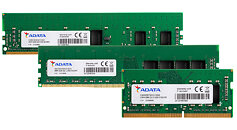Monday, April 13th 2020

ADATA Launches Industrial-Grade DDR4-3200 32GB Memory Modules
ADATA Technology, a leading manufacturer of high-performance DRAM modules, NAND Flash products, and mobile accessories is pleased to announce the launch of its industrial-grade 32 GB DDR4-3200 memory modules. With tested transfer rates of up to 3200 MT/s and 32 GB of capacity, the modules are ideal for segments and applications experiencing continuous growth of temporarily stored data as a result of 5G network and AIoT deployment, and thus require higher capacity and performance. These segments and applications include telecommunications, surveillance systems, autonomous vehicles, medical equipment, and industrial robots among others.
The modules come in U-DIMM, SO-DIMM, R-DIMM, ECC-DIMM, and ECC SO-DIMM variants and are compatible with the latest 3rd Gen AMD Ryzen and 10th Gen Intel Core processors. Made with the latest advancements in soldering and manufacturing. Utilizing a 288-pin design, operating voltage has been reduced from 1.5 V on DDR3 to 1.2 V, which not only helps save power by 20%, but also boosts transfer bandwidth speed.Amid worsening environmental conditions, industrial applications and related hardware are poised to face increasing threats, including pollution, moisture, corrosion, and extreme temperatures. ADATA DDR4-3200 32 GB memory modules feature anti-sulfuration technology to counter the harmful effects of silver sulfide buildup. These modules can also operate optimally in a wide range of temperatures, from -40°C to 85°C. The modules undergo sulfuration and reliability testing, which subjects their components to a high-sulfur, high-temperature, and high-humidity environment to confirm their compliance with the ASTM B809-95 specification.
All ADATA DDR4-3200 32 GB memory modules are produced and tested via a rigorous quality control process to ensure optimal performance and stable operation. They also meet strict JEDEC and RoHS standards to guarantee compatibility, stability, and environmentally friendliness.
The modules come in U-DIMM, SO-DIMM, R-DIMM, ECC-DIMM, and ECC SO-DIMM variants and are compatible with the latest 3rd Gen AMD Ryzen and 10th Gen Intel Core processors. Made with the latest advancements in soldering and manufacturing. Utilizing a 288-pin design, operating voltage has been reduced from 1.5 V on DDR3 to 1.2 V, which not only helps save power by 20%, but also boosts transfer bandwidth speed.Amid worsening environmental conditions, industrial applications and related hardware are poised to face increasing threats, including pollution, moisture, corrosion, and extreme temperatures. ADATA DDR4-3200 32 GB memory modules feature anti-sulfuration technology to counter the harmful effects of silver sulfide buildup. These modules can also operate optimally in a wide range of temperatures, from -40°C to 85°C. The modules undergo sulfuration and reliability testing, which subjects their components to a high-sulfur, high-temperature, and high-humidity environment to confirm their compliance with the ASTM B809-95 specification.
All ADATA DDR4-3200 32 GB memory modules are produced and tested via a rigorous quality control process to ensure optimal performance and stable operation. They also meet strict JEDEC and RoHS standards to guarantee compatibility, stability, and environmentally friendliness.

5 Comments on ADATA Launches Industrial-Grade DDR4-3200 32GB Memory Modules
I would like a scientific explanation for that. In the meantime I will call BS not only because I don't believe that lowering voltage increases bandwidth, but because the term "bandwidth speed" makes no sense at all.
Clearly a comma is missing from the sentence 1.5V on DDR3, to 1.2V (on DDR4).
If we cross out the absurd added thing like speed... Bandwidth is related to voltage and gain. You have situations for certain amplifiers where lowering voltage ends up in higher usable bandwidth in conjunction with your desired gain ratio... okay this is way more complicated... as life is really, as there are much more variables, like dielectric isolation properties, heat etc. But not here for sure.
A study to read during COVID-19 stand by. Some good observations about RAM operational points depending on voltage and latency.